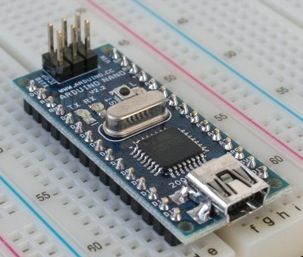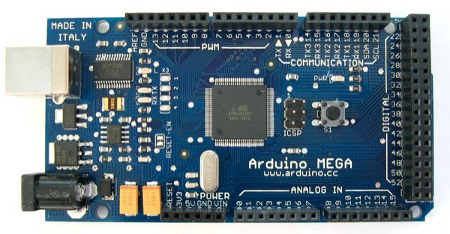Android app controls Arduino devices via Bluetooth
Jun 11, 2010 — by Eric Brown — from the LinuxDevices Archive — 8 viewsThe Amarino project has released source code for Amarino 2.0, a development kit that lets Android phones control mobile devices based on Arduino microcontrollers via Bluetooth. The Amarino 2.0 Android library enables control of multiple Bluetooth devices in parallel, says the project.
Amarino for the first time lets Android developers and more casual Android hobbyists control an expanding array of devices that run on the open-platform Arduino microcontroller boards. Based on Atmel ATmega microcontrollers, the Arduino devices include everything from simple robots, to wearable computers, to mote sensor network devices, to embedded components integrated in other more complex devices.

Arduino's Nano board
Arduino boards don't run embedded Linux or any other operating system directly, but are available with Arduino libraries for desktop Linux. The libraries enable developers to control the devices and integrate other applications and devices. (See farther below for more on Arduino.)
Amarino is said to be based on a project developed at the MIT Media Lab. The software lets Android phones control Arduino-based devices via Bluetooth, says the Amarino project. Typical applications are said to range from remote notification of Android events such as incoming phone calls to more complex machine control projects.
"Wouldn't it be thrilling to make those phone events visible somewhere else," explains the Amarino website. "On your wearable, in your living room, on your robot, in your office or where ever you want it to occur? Or would you like to use your smartphone sensors, like the accelerometer, light sensor, compass or your touchscreen to control other devices?"
Visual feedback and vibrating shirts
Other suggested applications include turning an Android phone into a home automation controller or displaying text messages on a ticker device. Then there's this irresistible project idea: making a shirt that vibrates when the phone rings.
Billing Amarino as "'Android meets Arduino," the project offers free downloads of the open source Amarino 2.0 toolkit, which is touted as offering easy access to internal Android phone events. The event code can then be further processed on the Arduino open-source prototyping platform, says the project.
The toolkit comprises an Android application, an Arduino library, and a sample application. Examples are provided that can help users build interfaces "almost without any programming experience," says the project.
Amarino 2.0 adds the following new features, says the project:
- visual feedback for events sent from the phone
- plug-in concept to integrate one's own events with Amarino (using its vizualizer for feedback)
- Support for Android 1.x and 2.x devices
- Introduces an Android library to talk to Amarino from one's app
- "Much clearer code"
Amarino is not alone in using Android as a controller of embedded devices. For example, robot manufacturer Surveyor Corp. last year released an open source SRV-1 Console Android app that controls its SRV-1 Blackfin Robot.
Arduino family keeps growing
Arduino has turned into one of the most successful embedded hardware hobbyist communities around. The Arduino boards can be used to prototype I/O platforms or create "interactive objects or environments," says the open oriented project.
The original Arduino Diecimila board was built around Atmel's AVR microcontrollers, either the ATmega8 or the ATmega168. It offers 11 digital and six analog inputs that support a wide variety of sensors, including GPS, temperature, humidity, light, presence, and pressure. The Arduino board responds to the sensors and can control lights, motors, and other actuators.
A smaller Arduino Nano (pictured earlier in this story) was introduced in 2008. The Nano offers the same functionality as the Arduino Diecimila, but is available in a "breadboard-ready" design that measures only 0.73 x 1.70 inches. The Nano was designed and manufactured by US-based Gravitech.
The Nano is equipped with an ATmega168 microcontroller clocked at 16MHz. It has 16KB of flash and 1KB of RAM. I/O includes a USB port with Mini-B jack, and a set of 14 digital I/O pins and eight analog inputs. There is also an ICSP programming header and an on-board regulator.

Arduino Mega: An Arduino with a bit of flash
(Click to enlarge)
The Mega has 54 digital input/output pins, of which 14 can be used as PWM outputs), says the project. The Arduino Mega is said to be further equipped with 16 analog inputs, four UARTs (hardware serial ports), a 16MHz crystal oscillator, and a USB connection. A power jack, an ICSP header, and a reset button rounds out the spec list.
Availability
Amarino 2.0 for Android is available now for free download. The Amarino project, with links to downloads, may be found here.
More information on Arduino may be found at the project web site, here, and more on the Arduino for Linux libraries may be found here.
This article was originally published on LinuxDevices.com and has been donated to the open source community by QuinStreet Inc. Please visit LinuxToday.com for up-to-date news and articles about Linux and open source.